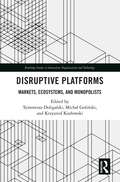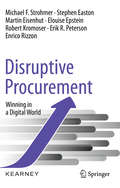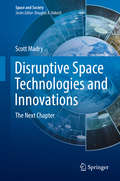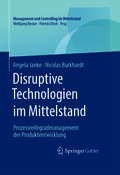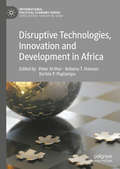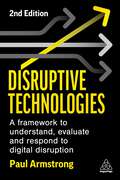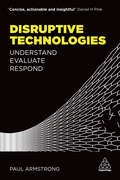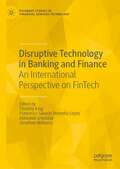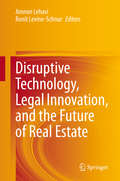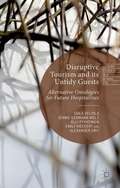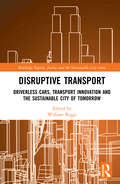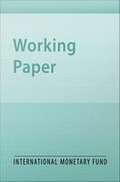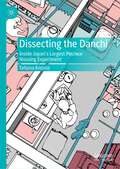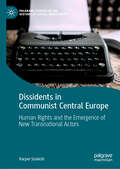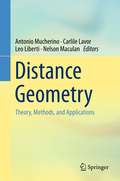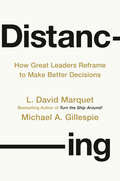- Table View
- List View
Disruptive Platforms: Markets, Ecosystems, and Monopolists (Routledge Studies in Innovation, Organizations and Technology)
by Tymoteusz Doligalski, Michał Goliński, and Krzysztof KozłowskiIt has taken platforms only twenty years to become digital economy hubs. They have changed markets, enterprises, and society. They have expedited communication, collaboration, and trade for consumers, winning their attention and collecting their data. In doing so, they have made processes, products, and industries obsolete, and disrupted the expectations and behaviours of market players. This raises the question, are digital platforms global innovators or disruptive monopolists? Are they a solution to problems of the past or emissaries of a problematic future? This book provides a multi-faceted approach to platforms and their profound impact on markets and ecosystems. Economic, managerial, social, and political aspects are analysed, and the differentiation of platforms and their disruptive potential is reviewed. The book also examines the mechanism of achieving a monopolistic position, including in the international supply chain, and the greater influence of platforms on political activity and contemporary democracy. With examples from Poland, USA, and China, the contributions offer an international evaluation of disruptive platforms across a multitude of industries. The edited collection, prepared by scholars from the SGH Warsaw School of Economics, will be valuable to researchers and academics across the fields of strategic management, marketing, innovations, international business, and the digital economy.
Disruptive Procurement: Winning in a Digital World
by Michael F. Strohmer Stephen Easton Robert Kromoser Martin Eisenhut Elouise Epstein Erik R. Peterson Enrico RizzonDisruptive Procurement is a radical new approach to creating value and innovation by challenging the status quo in the entire product and service line. It requires going far beyond conventional desktop procurement to understand the value the company brings to its customers as well as the value that suppliers bring to the company. By combining knowledge of these two dimensions, companies become far more flexible and they move closer to disrupting the environment in ways that create value. To move toward Disruptive Procurement, companies need a holistic view and a complete new set of capabilities for staff in marketing, sales, R&D, manufacturing, innovation, and, of course, procurement. This will only happen if procurement is fully backed by the Chief Executive Officer and companies embrace digital tools that will help make procurement slimmer and smarter.
Disruptive Selling: A New Strategic Approach to Sales, Marketing and Customer Service
by Patrick MaesThe heyday of the classic sales force is over. Customers lead mobile and online lives, and successful companies use disruptive concepts to engage with the digitally empowered consumer. Disruptive Selling helps companies transform themselves to the new age of selling by matching supply to demand in an innovative way. Successful disruptive selling concepts must be based on the right combination of a series of factors, including an understanding of what motivates customers' corresponding value propositions, appropriate organizational structures, and the right overarching business culture. Disruptive Selling demystifies all of this, and more. Featuring case studies and examples from disruptive organizations such as AirBnB, Zalando and Bol.com, this book will empower readers to look critically at their organizations and commercial interaction models, and begin their own disruptive selling journeys. It contains a carefully researched, clearly explained framework to disruptive selling, and practical guidelines that will allow readers to get started immediately. Regardless of industry, sector or company-size, Disruptive Selling is the ultimate guide to remaining competitive and adaptive in a continually changing world.
Disruptive Space Technologies and Innovations: The Next Chapter (Space and Society)
by Scott MadryIn the past century alone, we have witnessed groundbreaking technological innovations quickly displace established industries, thereby opening up entirely new markets or fields of research. Such "disruptive technologies" are hard to predict in advance, and yet, they have the potential to significantly alter the course of history. Written by one of the world’s leading space applications experts, this book addresses the concept of disruptive technologies in the space arena, including microsatellites, the development of satellite constellations, and reusable launch vehicles.The book presents several case studies in the field, and discusses how and why modern space technologies are so unique. It covers current examples of disruptive space businesses, the pros and cons of such disruption, key emerging trends, and possible developments on the horizon.
Disruptive Technological Change in the Mechanical Excavator Industry
by Clayton M. ChristensenThis chapter explores changes in the mechanical excavator industry, particularly with the advent of hydraulics. Despite the fact that this industry moves at a very different pace and technological intensity than the disk drive industry, the same factors precipitated the failure of both industries to remain competitive in the face of rapid technological change. This chapter was originally published as chapter 3 of "The Innovator's Dilemma: When New Technologies Cause Great Firms to Fail."
Disruptive Technologien im Mittelstand: Prozessreifegradmanagement der Produktentwicklung (Management und Controlling im Mittelstand)
by Angela Janke Nicolas BurkhardtDisruptive Technologien in Produktion und Produkten sind angesichts der Digitalisierung der Dinge (Internet of Things – IoT), Industrie 4.0, des Trends zu erneuerbaren Energien sowie der verstärkten Kundenindividualisierung von zunehmender Bedeutung. Die aktuelle Forschungsliteratur jedoch widmet sich primär dem Erfolg junger Unternehmen und dem Misserfolg etablierter Marktführer im Umfeld disruptiver Technologien. Ziel dieses Buchs ist es, diese Lücke zu schließen und die Möglichkeiten und Grenzen des Prozessreifegradmanagements bei der Entwicklung von Produkten auf Basis disruptiver Technologien zu klären. Es bietet dem Leser ein Reifegradmodell zur Selbstbewertung sowie die Gelegenheit, ein Benchmarking mit dem Best Practice und bewertungsbasierende Handlungsempfehlungen umzusetzen.
Disruptive Technologies and Optimization Towards Industry 4.0 Logistics (Springer Optimization and Its Applications #214)
by Panos M. Pardalos Athanasia Karakitsiou Athanasios MigdalasThis contributed volume guides researchers and practitioners on resource collaborative management of supply chains and manufacturing enterprises within an industrial internet technological environment. The book comprises 10 chapters that cover two major topics in the subject of logistics 4.0, namely the utilization of both disruptive technologies and optimization techniques in smart logistic management. With global research on the book's topic expanding rapidly across various directions and disciplines, it provides a structured framework for international experts to showcase outstanding work and unique approaches. Researchers and students will find the comprehensive outline on collaborative optimization and management of smart manufacturing and production, warehousing, inventory, logistics, transportation, integrated supply chain, and supply network within the industrial internet platform a beneficial guide to understanding current and future practical problems that arise in manufacturing and supply chain management.
Disruptive Technologies, Innovation and Development in Africa (International Political Economy Series)
by Kobena T. Hanson Korbla P. Puplampu Peter ArthurThis book examines how disruptive technologies and innovation underpin the attainment of a broader development agenda in Africa. Contributors show how distinctive forms of technological innovation can impact critical development processes. For example, disruptive technologies can deepen the ongoing democratic and governance waves in Africa, specifically in the area of contested elections. Similarly, innovations in agriculture, the environment and energy promote changes in value chain agriculture, and the use of sensors to manage e-waste and sustainable energy conservation are also transforming established practices. Furthermore, the role of disruptive technologies and innovation in education, health, financial services and the nature of paid work cannot be ignored. Individually and collectively, the authors discuss and highlight the mechanisms and initiatives that can contribute to the realization of the development goals of African countries, especially in a period where disruptive technologies are rapidly changing how things are done. As a result, this book, which represents one of the most recent systematic efforts to bring together dialogue on disruptive technologies in Africa, will be of particular use and benefit to a wide and an eclectic audience.
Disruptive Technologies: A Framework to Understand, Evaluate and Respond to Digital Disruption
by Paul ArmstrongThe next two decades will see more waves of technological disruption than the previous fifty. Adaptability and understanding of technological changes are now mission-critical to every business.Disruptive Technologies offers a three-step framework that enables readers to choose how their business responds to technological upheaval rather than being led by changes forced upon them. Showing how to understand a new technology, evaluate the challenge it poses, and finally respond to it, readers will come away secure in the knowledge that they have a workable system with which they can navigate ongoing technological disruption. This second edition features new chapters on the Metaverse and Web 3.0, as well as case studies and discussions of emerging technologies such as NFTs, artificial intelligence, virtual and augmented reality, graphene and 3D/4D printing.If companies do not grasp how developing technologies will impact their operations, supply chains, people and products, they have little hope of weathering the ongoing storm of digital disruption. Disruptive Technologies is your essential guide to creating a stable response to constant technological upheaval.
Disruptive Technologies: Understand, Evaluate, Respond
by Paul ArmstrongDisruptive Technologies outlines the steps businesses can take to engage with emerging technologies today in order to serve the consumer of tomorrow. This book offers the knowledge and tools to engage confidently with emerging technologies for better business. This highly practical book offers organizations a distinct response to emerging technologies including Blockchain (Bitcoin), artificial intelligence, graphene and nanotechnology (among others) and other external factors (such as the sharing economy, mobile penetration, millennial workforce, ageing populations) that impact on their business, client service and product model.Disruptive Technologies provides a clear roadmap to assess, respond to and problem-solve: what are the upcoming changes in technology, roughly when to respond, and what's the best response? By using a quick-to-master evaluation and decision-making framework - structured around the key dimensions of Technology, Behaviour and Data (TBD). Emerging technologies guru Paul Armstrong offers a clear guide to the key disruptive technologies and a toolbox of frameworks, checklists, and activities to evaluate their possibilities. Disruptive Technologies enables forecasting of potential scenarios, implementation of plans, alternative strategies and the ability to handle change more effectively within an organization. The essential tool for all professionals who need to get to grips with emerging technologies fast and strategically.
Disruptive Technology a Heartbeat Away: Ecton, Inc.
by Clayton M. Christensen Edward G. CapeDescribes an innovating start-up company with a disruptive technology to the large, expensive echocardiography machines that leading cardiologists use to create images of heart functions for diagnostic purposes. Ecton's machine is small, cheap, portable, and can't create images as clear as those that large, expensive instruments can make. The entrepreneur is searching for a market for his product, and wonders whether he should sell out or try to build a successful commercial organization.
Disruptive Technology and Business Continuity: Proceedings of The 5th International Conference on Business (ICB 2023)
by Le Thanh Tung Nguyen Hoang Sinh Pham HaThis book offers an up-to-date and comprehensive picture of the Vietnamese economy, which is the fast-growing economy in Southeast Asia. The country has invested heavily in education, health, and development infrastructure across the country. Progress in recent decades has been strong and Vietnam has attracted significant relocation and outsourcing of production from The Organization for Economic Cooperation and Development (OECD) countries. In the recent years, much of the foreign direct investment from China has been channeled to Vietnam. The state’s development policy has created optimal conditions for further expansion of production, supply chain, education and finances. Investment in education, health, infrastructure, administration and regulations is facilitating investment inflows, technology transfer and spillover to the growing national companies. The educated young population and disciplined labor force have provided a strong basis for the growth of the economy. The high level of productivity, improved quality of products, low and competitive cost of production, and over 100 million people provide a strong base for a continuous economic growth. This edited volume, brings together selected papers presented at The 5th International Conference on Business (ICB 2023), providing good insights into the features of the economy and its development potential. They provide an up-to-date overview and an empirical research-based picture of the recent trends in Vietnam's economic development. The book would be a useful read for educators, undergraduate and graduate students, domestic and foreign investors, government agencies, provincial and industrial sector decision-makers, trade partners, libraries, individual researchers, and professional and practitioners. It helps to fill the gap in knowledge and inform development planners and investors about different sectors of the Vietnamese economy and its development potential.
Disruptive Technology in Banking and Finance: An International Perspective on FinTech (Palgrave Studies in Financial Services Technology)
by Jonathan Williams Timothy King Francesco Saverio Stentella Lopes Abhishek SrivastavThis book exemplifies the potential of FinTech to deliver important economic and societal gains, such as enhancing competition and financial inclusion to deliver tailored financial products and services at more affordable prices and at greater convenience. The emergence of FinTech directly challenges the business models of incumbent financial intermediaries like banks, which are adapting by developing their own FinTech offerings and partnering with FinTech and large technology firms. FinTech also constitutes both known and unknown risks to financial stability and challenges regulators to evaluate whether existing regulations are sufficient. The emergence of FinTech as a global phenomenon requires insightful cross-country analysis and different perspectives to evaluate its development and associated opportunities and challenges. This book will be of interest to practitioners, regulators and students of this essential enabling technology that is a major component of the Fourth Industrial Revolution.
Disruptive Technology in Human Resource Management (Routledge Studies in Innovation, Organizations and Technology)
by Sumedha Dutta Asha Thomas Puja KhatriTechnological breakthroughs obliterate established methods and change entire industries. Disruptive technologies are seen as drivers of various business processes, and one area that these technologies have had a profound impact on is human resource management (HRM). The applications of disruptive technology in the field of HRM represent an ever-intriguing domain for researchers and professionals. These technologies have altered the processes of acquitting, hiring, training, and managing employees. The book Disruptive Technology in Human Resource Management is an attempt to lucidly explain the significant makeover introduced by a few significant disruptive HRM technologies - artificial intelligence, blockchain, big data/data analytics, robotics, cloud computing, digital transformation, and social media. It examines how disruptive technologies have impacted the evolution of numerous HR practices, including but not limited to recruitment, selection, orientation, training, employee welfare, performance evaluation, pay structure, and job design.Corporate examples help highlight the manner in which the amalgamation of disruptive technology with HRM has increased the strategic relevance of HRM. The book provides tools, tactics, and perspective to innovate, push oneself, excite others, and establish a world-changing disruptive business model. This real-world book provides concise insights into how disruptive technology open doors to in-cash multifold HRM opportunities.Combining theory with practice, this volume will be of value to scholars and upper-level students across HRM, and technology and innovation management.
Disruptive Technology, Legal Innovation, and the Future of Real Estate
by Amnon Lehavi Ronit Levine-SchnurThis book addresses challenges that new technologies and the big data revolution pose to existing regulatory and legal frameworks. The volume discusses issues such as blockchain and its implications for property transactions and taxes, three (or four) dimensional title registration, land use and urban planning in the age of big data, and the future of property rights in light of these changes. The book brings together an interdisciplinary collection of chapters that revolve around the potential influence of disruptive technologies on existing legal norms and the future development of real estate markets. The book is divided into five parts. Part I presents a survey of the current available research on blockchain and real estate. Part II provides a background on property law for the volume, grounding it in fundamental theory. Part III discusses the changing landscapes of property rights while Part IV debates the potential effects of blockchain on land registration. Finally the book concludes with Part V, which is devoted to new technological applications relevant to real estate. Providing an interdisciplinary perspective on emerging technologies that have the potential to disrupt the real estate industry and the regulation of it, this book will appeal to a broad audience, consisting of scholars, policy-makers, practitioners, and students, interested in real estate, law, economics, blockchain, and technology policy.
Disruptive Tourism and its Untidy Guests
by Soile VeijolaThis book invokes the radical potentialities of 'untidiness' to envision alternative arrangements of social life and hospitality. Instead of trying to manage sustainability or tidy up tourist situations, the authors embrace the messiness of human relations and argue for more creative, embodied and ethical ontologies of tourism and mobility.
Disruptive Transport: Driverless Cars, Transport Innovation and the Sustainable City of Tomorrow (Routledge Equity, Justice and the Sustainable City series)
by William RiggsWith the rise of shared and networked vehicles, autonomous vehicles, and other transportation technologies, technological change is outpacing urban planning and policy. Whether urban planners and policy makers like it or not, these transformations will in turn result in profound changes to streets, land use, and cities. But smarter transportation may not necessarily translate into greater sustainability or equity. There are clear opportunities to shape advances in transportation, and to harness them to reshape cities and improve the socio-economic health of cities and residents. There are opportunities to reduce collisions and improve access to healthcare for those who need it most—particularly high-cost, high-need individuals at the younger and older ends of the age spectrum. There is also potential to connect individuals to jobs and change the way cities organize space and optimize trips. To date, very little discussion has centered around the job and social implications of this technology. Further, policy dialogue on future transport has lagged—particularly in the arenas of sustainability and social justice. Little work has been done on decision-making in this high uncertainty environment–a deficiency that is concerning given that land use and transportation actions have long and lagging timelines. This is one of the first books to explore the impact that emerging transport technology is having on cities and their residents, and how policy is needed to shape the cities that we want to have in the future. The book contains a selection of contributions based on the most advanced empirical research, and case studies for how future transport can be harnessed to improve urban sustainability and justice.
Dissecting Discrimination: Identifying Its Various Faces and Their Sources (Entscheidungs- und Organisationstheorie)
by Daniel VilligerThis Open-Access-book examines the phenomenon of discrimination using a descriptive approach. Discrimination is omnipresent, whether it is people who discriminate against other people or, more recently, also machines that discriminate against people. The first part of the analysis employs decision theory on discrimination, leading to two fundamental subtypes: taste-based discrimination and statistical discrimination. The second part links taste-based discrimination to social identity theory, demonstrates that not all taste-based discrimination is ultimately statistical discrimination, and reveals the evolutionary origins of our tastes. The third part surveys how people get their beliefs for statistical discrimination and thereby shows that they often deviate from Bayesianism: they have inherent prior beliefs and do not exclusively update their beliefs according to Bayes’ law. Additionally, the analysis of belief formation highlights the importance of the learning environment. The last part reassembles the previously dissected aspects of discrimination, presents a new descriptive model of discrimination, and lists five implications for a normative theory of discrimination.
Dissecting Taylor Rules in a Structural VAR
by Woon Gyu Choi Yi WenA report from the International Monetary Fund.
Dissecting the Danchi: Inside Japan’s Largest Postwar Housing Experiment
by Tatiana KnorozThe book is the first to explore the history and political significance of the Japanese public housing program. In the 1960s, as Japan's postwar economy boomed, architects and urban planners inspired equally by Western modernism and Soviet ideas of housing as a basic right created new cityscapes to house populations turned into refugees by the war. Over time, as Japan's society aged and the economy began to stagnate, these structures have become a burden on society. In this closely researched monograph on the conditions of Japanese housing, Tatiana Knoroz sheds unexpected light on the rise and fall of the idea of social democracy in Japan which will be of interest to historians, architects, and scholars of Asian economic modernization.
Dissidents in Communist Central Europe: Human Rights and the Emergence of New Transnational Actors (Palgrave Studies in the History of Social Movements)
by Kacper SzuleckiThis monograph traces the history of the dissident as a transnational phenomenon, exploring Soviet dissidents in Communist Central Europe from the mid-1960s until 1989. It argues that our understanding of the transnational activist would not be what it is today without the input of Central European oppositionists and ties the term to the global emergence and evolution of human rights. The book examines how we define dissidents and explores the association of political resistance to authoritarian regimes, as well as the impact of domestic and international recognition of the dissident figure. Turning to literature to analyse the meaning and impact of the dissident label, the book also incorporates interviews and primary accounts from former activists. Combining a unique theoretical approach with new empirical material, this book will appeal to students and scholars of contemporary history, politics and culture in Central Europe.
Dissonance Is the Default: The Leader's Struggle to Sustain Resonance
by Annie Mckee Richard BoyatzisThis chapter explains how dissonance--often the result of pressure and unchecked stress--becomes the default and how easy it is, even for effective leaders who can be resonant, to slip into dissonance with themselves and others around them.
Distance Geometry
by Carlile Lavor Antonio Mucherino Leo Liberti Nelson MaculanThis volume is a collection of research surveys on the Distance Geometry Problem (DGP) and its applications. It will be divided into three parts: Theory, Methods and Applications. Each part will contain at least one survey and several research papers. The first part, Theory, will deal with theoretical aspects of the DGP, including a new class of problems and the study of its complexities as well as the relation between DGP and other related topics, such as: distance matrix theory, Euclidean distance matrix completion problem, multispherical structure of distance matrices, distance geometry and geometric algebra, algebraic distance geometry theory, visualization of K-dimensional structures in the plane, graph rigidity, and theory of discretizable DGP: symmetry and complexity. The second part, Methods, will discuss mathematical and computational properties of methods developed to the problems considered in the first chapter including continuous methods (based on Gaussian and hyperbolic smoothing, difference of convex functions, semidefinite programming, branch-and-bound), discrete methods (based on branch-and-prune, geometric build-up, graph rigidity), and also heuristics methods (based on simulated annealing, genetic algorithms, tabu search, variable neighborhood search). Applications will comprise the third part and will consider applications of DGP to NMR structure calculation, rational drug design, molecular dynamics simulations, graph drawing and sensor network localization. This volume will be the first edited book on distance geometry and applications. The editors are in correspondence with the major contributors to the field of distance geometry, including important research centers in molecular biology such as Institut Pasteur in Paris.
Distance, Rating Systems and Enterprise Finance: Ethnographic Insights from a Comparison of Regional and Large Banks in Germany (Routledge International Studies in Money and Banking)
by Franz FlögelIn response to the credit crunch during the global financial crisis of 2007–2008, many have called for the re-establishment of regional banks in the UK and elsewhere. In this context, Germany’s regional banking system, with its more than 1,400 small and regional savings banks and cooperative banks, is viewed as a role model in the financing of small and medium-sized enterprises (SMEs). However, in line with the ‘death of distance’ debate, the universal application of ICT-based scoring and rating systems potentially obviates the necessity for proximity to reduce information asymmetries between banks and SMEs, calling into question the key advantage of regional banks. Utilising novel ethnographic findings from full-time participant observation and interviews, this book presents intimate insights into regional savings banks and compares their SME lending practices with large, nationwide-operating commercial banks in Germany. The ethnographic insights are contextualised by concise description of the three-pillar German banking system, covering bank regulation, structural and geographical developments, and enterprise finance. Furthermore, the book advances an original theoretical approach that combines classical banking theories with insights from social studies of finance on the (ontological) foundation of new realism. Ethnographic findings reveal varying distances of credit granting depending on the rating results, i.e. large banks allocate considerable credit-granting authority to local staff and therefore challenge the proximity advantages of regional banks. Nevertheless, by presenting case studies of lending to SMEs, the book demonstrates the ability of regional banks to capitalise on proximity when screening and monitoring financially distressed SMEs and explains why the suggestion that ICT can substitute for proximity in SME lending has to be rejected.
Distancing: How Great Leaders Reframe to Make Better Decisions
by L. David Marquet Michael A. GillespieDistance gives you perspective. Bestselling author of Turn the Ship Around! former US Navy Captain David Marquet and professor of psychology Michael Gillespie show you how to make better decisions by becoming your own coach.Be yourself. Be fully present. Be in the moment. This is a message we hear constantly. While this may be beneficial some of the time, the biggest obstacle to making wiser decisions that actually drive lasting success is ourselves. Being fully immersed in our own limited point of view biases our decisions toward defending our previous actions and maintaining our self-image. We need to exit our me-here-and-now self and get an outside perspective that sees us and the situation we are in objectively. We need a coach.This book shows us how to become our own coach by using a mental technique called psychological distancing. We do this in three ways: self-distancing, spatial distancing, and temporal distancing. First, we can be someone else, inhabiting another&’s perspective. This activates the neutral observer&’s outside point of view. Second, we can be somewhere else. We zoom out and see ourselves from afar, as just another person who is part of a larger context. Third, we can be sometime else, imagining that we are our future selves who are thinking back to what we wish we had done today. In each case, we can coach ourselves from this distanced perspective. The result is a powerful and immediate reframe of how we see ourselves, our situation, and what we should do.Featuring compelling scientific research, business cases, and exercises, Distancing equips us with effective practical tools to reduce anxiety, see more clearly, and make better decisions for ourselves and for our organizations.
